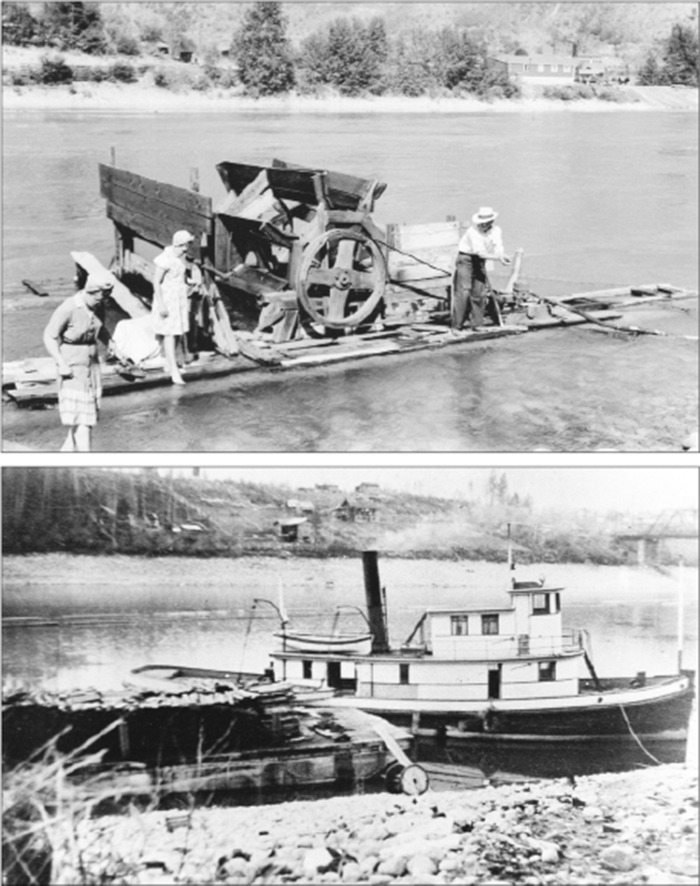As Castlegar’s first homesteader soon found out, any serious farming required irrigation.
Although his ferry operation kept him at riverside, Albert McCleary turned instead to what would become Bloomer Creek as a gravity-driven water source to support his commercial gardening enterprise, which was supplemented by sheep rearing.
After he sold out to Edward Mahon in 1891 his agricultural enterprise was soon reabsorbed by brushwood and forest, to remain a wilderness again for three decades.
As we saw in my last essay, a degree of reawakening in Edward’s dormant city was made possible by subdivision and marketing of Lot 4598, which provided new unencumbered land for growth. Riverside lots became available north of Cedar (1st) St. and houses sprung up below the alluvial terrace, as close as possible to the river. Various ways were devised to tap into its unfailing water supply.
The simplest method was to simply haul the water in buckets, which in the days of true water conservation seemed adequate.
Joe Tekles, the previous occupier of my property, built a long elevated platform from his cabin towards the river bank. From its end he suspended a cable that angled into the water some 60 feet (18 m) below. A pulley could take a bucket down the line for a quick refill, saving him a lot of walking. I can actually see the structure in a blow-up of a Jack LaRocque photograph. Tekles perished in the early morning of Nov. 16, 1954 when his home burnt to the ground.
A more sophisticated method of getting river water upgrade was with a water wheel. This ingenious structure employed the river current to propel a paddlewheel, which in turn powered a pump that could deliver water to a considerable distance and elevation. There were three water wheel operations downstream of the train bridge.
William Ozeroff lived on the lower portions of what is now the Obedkoff property. Slightly downstream was a second structure maintained by John and Fred Makaroff. The most ambitious scheme was developed by Paul Zaitsoff, an early farmer on Block 59 of the Mahon Subdivision.
His water wheel was located at the foot of Cedar St. and it supplied a line that ran for several blocks to an elevated water tank (water tower) that was located near the present-day Catholic church. The Eremenkos had a similar water tower on their property behind their house and store, just upstream of the train bridge.
As can be seen in the photograph, the water wheel was basically a raft that had to be kept just offshore so it was always fully afloat and allowed free movement of the paddlewheel. The wheel speed could be regulated by a gate just upstream of it, which determined how much current force was applied to the paddles. A large wooden pulley transferred the rotational torque to a greatly speeded-up pulley on the pump.
By the 1940s communal water systems were being developed to replace these ingenious devices.
A LaRocque photograph shows only the Zaitsoff water wheel was still operating in 1948, and the new water tower behind the original Castlegar Co-operative Transportation Society building was in place. The CPR had provided water from their supply off a small tributary of Bloomer Creek to nearby residents until the new system replaced it. A similar system was developed in Kinnaird. Concrete pillars that housed the pumps for these communal systems can still be seen along the river shoreline.
River water was abandoned as the city water supply when a cost-sharing agreement for the construction of wells was signed in 1960 with the Celgar pulp mill. In addition to effluent from the mill, siltation caused during the construction of the High Arrow Dam (renamed Hugh Keenleyside) made river water unsuitable.
In 1979 the city returned to river water, now obtained from Lower Arrow Lake at the Celgar pumphouse just above Hugh Keenleyside Dam. An agreement between the city and the pulp mill regulates utilization and operational costs. As the spotlight has been put on the elevated levels of underground radioactivity in our area, the move back to surface water was a wise decision. With minimal industrial pollution upstream and the sedimentation of suspended solids in the reservoirs, our water supply is now second to none.
And so we adapt and learn lessons from an old friend. Our ‘Old Man River’ flows on, rewarding us daily with its presence, as the value of its gifts continues to increase.
Walter Volovsek’s website can be found at trailsintime.org
Previous installments in this series
Intrigues: Castlegar’s lacklustre childhood
Perceptions: Adrift on the River of Life
Local history interwoven with rivers
Drawn into the currents of time
